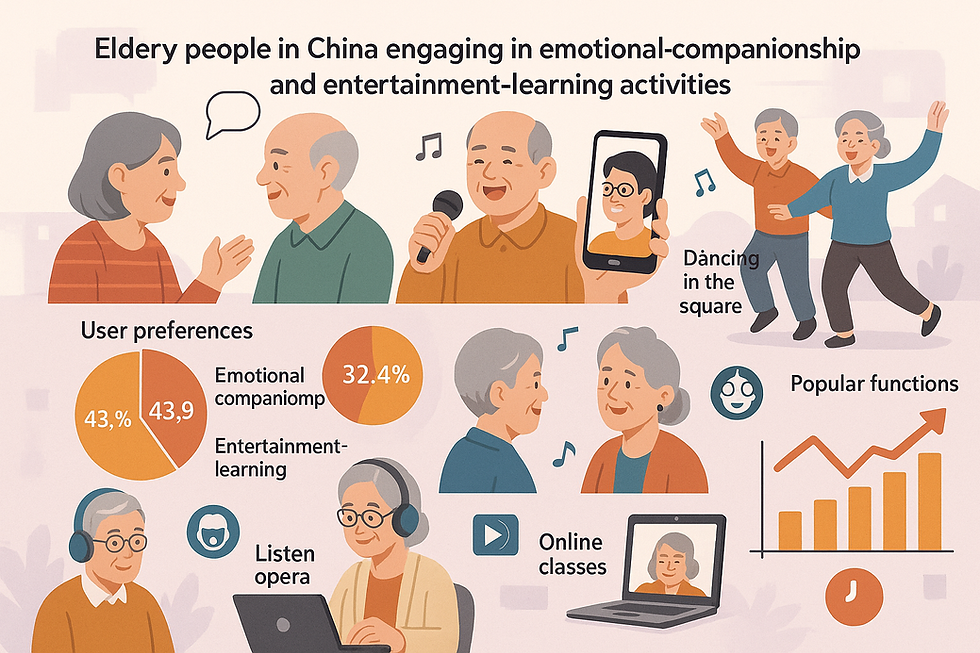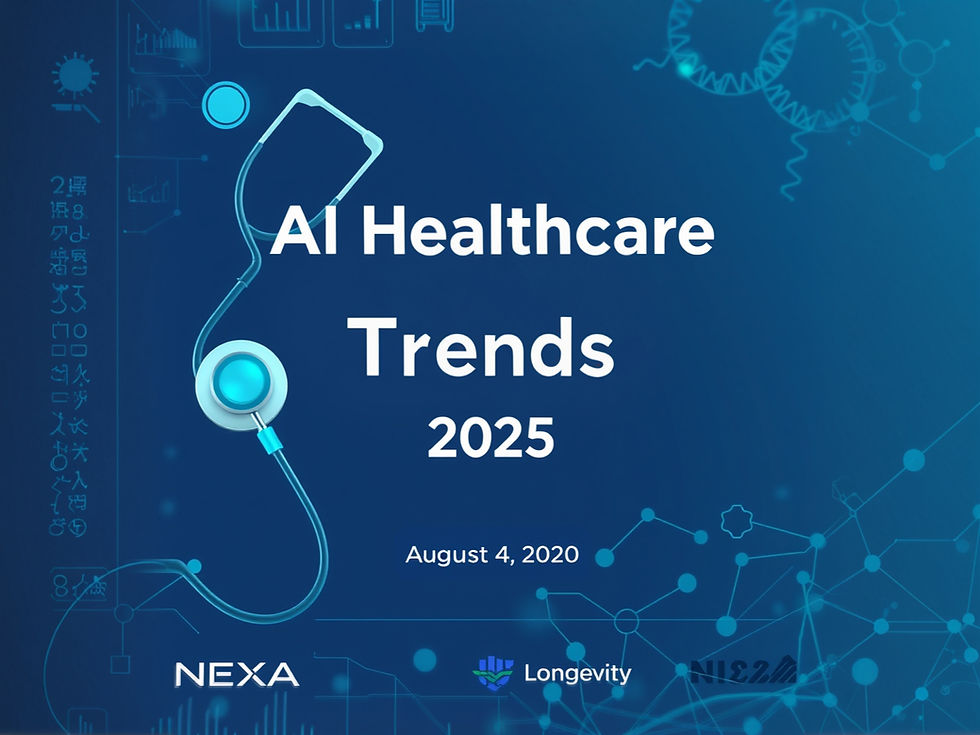Extending Healthspan: The Power of Digital Biomarkers and AI
- NXLongevity

- May 11
- 6 min read
Key Takeaways
Research indicates that digital biomarkers and artificial intelligence (AI) hold significant potential in healthcare, particularly in longevity medicine, possibly extending healthspan, but further validation is needed.
Evidence leans towards supporting the use of digital biomarkers in disease monitoring, personalized treatment, and clinical trials, especially in Parkinson's disease and cardiovascular conditions.
Opportunities for AI in longevity medicine include biomarker discovery, drug development, and disease prediction, with research showing promising prospects, though data privacy and standardization issues must be addressed.
Market forecasts suggest the digital biomarkers market could reach $243 billion by 2033, with AI and novel sensors driving more precise health monitoring.
Controversies revolve around data privacy and algorithmic bias, necessitating a balance between technological advancement and patient rights.
What are Digital Biomarkers?
Digital biomarkers are quantifiable physiological and behavioral data collected via digital devices such as smartphones, wearables, or sensors. These data are used to monitor health status, disease progression, and treatment efficacy, providing real-time, continuous insights that are more comprehensive than traditional clinical assessments.
How is the Market Growing?
Research shows that the global digital biomarkers market is rapidly expanding, with a market size of approximately $4.16 billion in 2024, projected to reach $243 billion by 2033, at a compound annual growth rate (CAGR) of 22.7%. North America currently dominates the market, but the Asia-Pacific region is expected to grow the fastest.
What is the Role of AI in Longevity Medicine?
AI demonstrates immense potential in longevity medicine by analyzing complex biological data, accelerating drug discovery, developing aging clocks, and personalizing treatment plans. Studies indicate AI can predict age-related disease risks, but privacy and ethical concerns must be addressed.
What Challenges Exist?
Data privacy, standardization, and regulation are primary obstacles. Research suggests that industry collaboration is needed to resolve these issues to ensure safe and equitable technology application.

1. Introduction
Digital biomarkers are quantifiable physiological, behavioral, or biological data collected through digital devices such as smartphones, wearables, and sensors. These data are used to monitor health status, disease progression, treatment outcomes, and overall health management, providing real-time, continuous insights that are more comprehensive than traditional sporadic clinical assessments. With the rapid advancement of digital health technologies, digital biomarkers are becoming a critical tool in driving precision medicine and personalized treatment in healthcare.
Artificial intelligence (AI), as a powerful technology, is showing tremendous potential in longevity medicine, which aims to extend healthspan by studying aging mechanisms and developing interventions. This report integrates market research on digital biomarkers in healthcare, their historical development, current applications, future trends, and the specific opportunities AI presents in longevity medicine, offering readers a comprehensive insight.
2. Market Research on Digital Biomarkers
2.1 Market Overview
According to the latest market research, the global digital biomarkers market is growing rapidly. In 2024, the market size is approximately $4.16 billion, expected to reach $243 billion by 2033, with a compound annual growth rate (CAGR) of 22.7%. North America currently holds the dominant position, accounting for about 44% of the market share, but the Asia-Pacific region is projected to grow at the fastest rate of 21.8% CAGR, reflecting the increasing demand for digital health technologies in emerging markets.
2.2 Application Areas
Digital biomarkers have a wide range of applications in healthcare, including:
Disease Monitoring: Real-time monitoring of physiological parameters such as heart rate, blood pressure, and blood glucose via wearables and smartphone apps.
Treatment Efficacy Assessment: Continuous tracking of patient progress to optimize treatment plans.
Remote Patient Monitoring: Reducing hospitalization time and healthcare costs, particularly in chronic disease management.
Early Disease Detection: Analyzing behavioral and physiological data to detect early signs of conditions like cardiovascular diseases and diabetes.
Personalized Treatment: Developing precise treatment plans based on individual data.
2.3 Key Players
Major players in the digital biomarkers market include:
Philips: A leader in remote patient monitoring and health data analysis.
Johnson & Johnson: Advancing clinical applications through medical devices and digital health platforms.
Pfizer: Exploring digital biomarkers in drug development and patient monitoring.
GE Healthcare: Focused on medical imaging and digital health technologies.
Siemens Healthcare: Providing advanced medical devices and digital solutions.
2.4 Technological Trends
The following technological trends are driving market growth:
AI and Machine Learning: Enhancing disease prediction and personalized treatment accuracy.
Wearables and Sensors: Making data collection more convenient and precise.
5G Networks: Accelerating data transmission and improving telemedicine efficiency.
Blockchain Technology: Addressing data security and privacy concerns.
2.5 Challenges and Opportunities
Challenges:
Data Privacy and Security: Protecting personal health data is a major barrier.
Regulation and Compliance: Varying regulatory policies across regions affect market access.
Technological Standardization: Lack of unified standards for data collection and analysis.
Opportunities:
Personalized Medicine: Providing a data foundation for precision healthcare.
Telemedicine Demand: Surging post-COVID-19, creating new growth points.
Government Support: Policies and funding promoting digital health technologies.
3. Historical Research and Current Applications of Digital Biomarkers
3.1 Origins and Development
The concept of digital biomarkers began to take shape around 2010, driven by the proliferation of smartphones and wearables. In 2016, a Rock Health report first systematically explored the potential of digital biomarkers, marking a rise in academic and industry attention. The COVID-19 pandemic further accelerated their application in remote monitoring and clinical trials.
3.2 Expansion of Research Fields
Early research focused on monitoring movement disorders like Parkinson's disease, using wearables to collect data for objective symptom assessment. The field has since expanded to cardiovascular diseases, mental health, and more. For example, a 2019 study used random forest classifiers to predict cardiovascular treatment responses.
3.3 Key Milestones
The following are key milestones in the historical research of digital biomarkers:
Year | Event/Milestone | Impact |
2010 | Surge in patent applications | Increased industry investment |
2016 | Rock Health report | Systematic definition of digital biomarkers |
2019 | Nature commentary | Pushed integration of digital and traditional biomarkers |
2020 | COVID-19 drives adoption | Accelerated remote monitoring |
2021 | DBDP open-source platform | Provided a standardized research environment |
4. Future Trends and Opportunities
4.1 Market Growth and Regional Distribution
By 2033, the global digital biomarkers market is expected to reach $243 billion, with North America maintaining its lead and the Asia-Pacific region experiencing the fastest growth.
4.2 Technological Innovations
AI and Machine Learning: Enhancing data analysis precision.
Novel Sensors: Expanding data collection capabilities.
5G Technology: Supporting real-time remote monitoring.
4.3 Deepening Clinical Applications
Personalized Treatment: Tailored interventions based on real-time data.
Clinical Trials: Providing objective, continuous endpoint metrics.
Disease Prevention: Enabling early intervention through predictive analytics.
4.4 Regulatory and Ethical Challenges
Regulatory Frameworks: Need for global standardization.
Ethical Issues: Data privacy and algorithmic bias must be addressed.
5. Opportunities and Applications of AI in Longevity Medicine
5.1 Biomarker Discovery and Aging Clocks
AI can analyze multi-omics data to identify aging-related biomarkers. The 2018 deep aging clock provided precise estimates of biological age.
5.2 Drug Discovery and Development
AI accelerates the discovery of geroprotectors using generative adversarial networks (GANs) to identify novel targets.
5.3 Personalized Medicine
AI integrates genetic and lifestyle data to design customized interventions, improving treatment outcomes.
5.4 Disease Prediction and Prevention
AI predicts risks of diseases like Alzheimer's, promoting early intervention.
5.5 Research and Clinical Applications
AI accelerates aging mechanism research and aids clinical decision-making, such as remote monitoring of elderly patients.
5.6 Education and Standardization
The Healthy Longevity Medicine Society (HLMS) is developing guidelines for biomarker validation.
5.7 Economic and Social Impact
AI can reduce healthcare costs and support independent living for the elderly, improving quality of life in aging societies.
The following table summarizes the opportunities for AI in longevity medicine:
Opportunity | Description | Expected Impact |
Biomarker Discovery | Identify aging biomarkers, develop aging clocks | Enhance health monitoring precision |
Drug Discovery | Accelerate geroprotector development | Shorten R&D cycles |
Personalized Medicine | Tailor health interventions | Extend healthspan |
Disease Prediction | Predict disease risks | Reduce disease burden |
Research and Clinical | Accelerate research, optimize care | Improve efficiency |
Education and Standardization | Develop guidelines | Promote industry standardization |
Economic Impact | Lower healthcare costs | Enhance societal well-being |
6. Conclusion
The integration of digital biomarkers and AI is reshaping healthcare, particularly in longevity medicine. From market growth to technological innovation and deepening clinical applications, these technologies offer unprecedented opportunities to extend healthspan. However, data privacy, standardization, and ethical issues require industry collaboration to resolve. As technology advances, digital biomarkers and AI are set to significantly transform healthcare over the next decade.




Comments